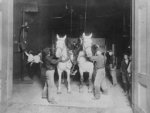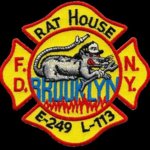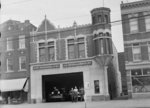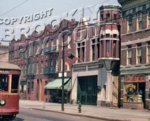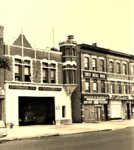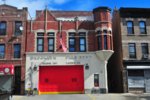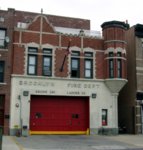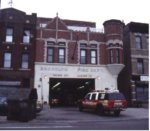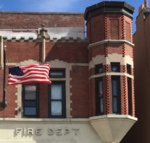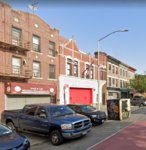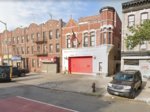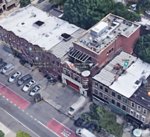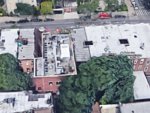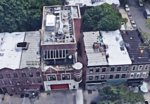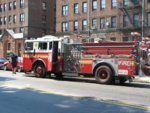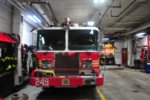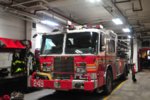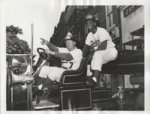You are using an out of date browser. It may not display this or other websites correctly.
You should upgrade or use an alternative browser.
You should upgrade or use an alternative browser.
FDNY and NYC Firehouses and Fire Companies - 2nd Section
- Thread starter mack
- Start date
Firehouse Quotes – from Florida FDNY retirees
- “If my helmet could talk, it would cough.
- “You’re on the job, now get into the job.
- “I’m going horizontal.
- “You got 2 switches, ‘on’ and ‘moron’.’’
- “Eat till you’re tired, sleep till you’re hungry, stay safe.”
- “Engine turn out, truck turn over.”
- “Make your words sweet incase you have to eat them.”
- “You’re the chief, I am nothing. That makes you the chief of nothing.”
- “Give the hardest job to the laziest guy and he’ll find the easiest way to do it.”
- “My father did 30 years OTJ before I got on and he told me a few good ones from back when. He said that at multiples alarms the chiefs would say ‘Save the horses. The firemen we get for free’.”
- “This job is so easy, it’s hard.”
- Meal instructions – “Make a lot, make it late.”
- “You’re going to be a big man on this job.”
- “Don’t stand when you can sit down, don’t sit down when you can lay down.”
- “I heard it in the kitchen. It has to be true.”
- “Could you pass down the flavor?”
- “What you see here, what you say here, when you leave here, let it stay here.”
- “Hey kid, who told you about this job?”
- “Never delay the end of a meeting or the start of a cocktail hour.”
- “The most important toll on this job is a well-rested firefighter.”
- “After a job, the engine goes to the burn center and the truck goes to the typewriter.”
- “Eat till you sleep, sleep till you eat.”
- “I have more time sliding the pole than you have on the job, kid.”
- “You got to step up to f**k up – and you really stepped up.”
- “You’re like a blister. You come out when the work is done.”
- “The worst part about doing nothing is you never know when you are done.”
- “Half the knowledge in this world can be found seated around this table. The other half comes in to work at 6 PM tonight.”
- “I’ve got more time waiting for water than you have on the job.”
- “No matter where you go, it’s the same circus with different clowns.”
- “Do something, anything, even if it is wrong.”
- Junior man – “I’ve got a great idea.” Senior man – “Good. Go lay down till it goes away.”
- “FDNY – 200 years of tradition unimpeded by progress.”
- “That guy’s retirement party is going to be in a phone booth.”
- “You don’t have to like it. You just have to pay for it.”
- “Listen Johnny, I’ve got more time on roofs than Santa Claus.”
Engine 249/Ladder 113 firehouse 491 Rogers Avenue Prospect Lefferts Gardens/Flatbush, Brooklyn Division 15, Battalion 38 "Camp Rogers Rats"
Engine 49 BFD organized 491 Rogers Avenue w/Ladder 23 BFD 1896
Engine 49 BFD became Engine 49 FDNY 1898
Engine 49 became Engine 149 1899
Engine 149 became Engine 249 1913
Engine 249 relocated to 489 St Johns Place at Engine 280 1996
Engine 249 returned to 491 Rogers Avenue 1997
Ladder 23 BFD organized 491 Rogers Avenue w/Engine 49 BFD 1896
Ladder 23 BFD became Ladder 23 FDNY 1898
Ladder 23 became Ladder 13 1898
Ladder 13 became Ladder 63 1899
Ladder 63 became Ladder 113 1913
Ladder 113 relocated to 2900 Snyder Avenue at Engine 248 1996
Ladder 113 returned to 491 Rogers Avenue 1997
Pre-Brooklyn Fire Department:
The town of Flatbush was protected by the Flatbush Fire Department. Volunteer companies included:
Washington Engine 1
Melrose Hose
Malbone Hose
Woodbine Hose
Windsor Hose
Washington H&L 1
Farmer H&L 2
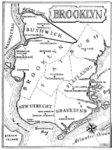
Flatbush became part of the City of Brooklyn in 1894. The Brooklyn Fire Department expanded and organized paid fire companies from volunteer firefighter applicants.

Engine 49 BFD organized 491 Rogers Avenue w/Ladder 23 BFD 1896
Engine 49 BFD became Engine 49 FDNY 1898
Engine 49 became Engine 149 1899
Engine 149 became Engine 249 1913
Engine 249 relocated to 489 St Johns Place at Engine 280 1996
Engine 249 returned to 491 Rogers Avenue 1997
Ladder 23 BFD organized 491 Rogers Avenue w/Engine 49 BFD 1896
Ladder 23 BFD became Ladder 23 FDNY 1898
Ladder 23 became Ladder 13 1898
Ladder 13 became Ladder 63 1899
Ladder 63 became Ladder 113 1913
Ladder 113 relocated to 2900 Snyder Avenue at Engine 248 1996
Ladder 113 returned to 491 Rogers Avenue 1997
Pre-Brooklyn Fire Department:
The town of Flatbush was protected by the Flatbush Fire Department. Volunteer companies included:
Washington Engine 1
Melrose Hose
Malbone Hose
Woodbine Hose
Windsor Hose
Washington H&L 1
Farmer H&L 2

Flatbush became part of the City of Brooklyn in 1894. The Brooklyn Fire Department expanded and organized paid fire companies from volunteer firefighter applicants.
Engine 249/Ladder 113 (continued):

ENGINE 249 AND LADDER 113
FLATBUSH AND THE CAMP
Engine 249 and Ladder 113 were placed in service on January 20, 1896. Then it was not part of the FDNY and the fire trucks were not painted white over red or diesel powered. One hundred years ago both, rigs were pulled buy a team of horses and were painted a 2 tone green. Engine 249 and Ladder 113 were called Engine 49 and Ladder 23 back then and were part of the City of Brooklyn, the fourth largest city in the country.
One hundred years ago a new tradition was started, a paid fire department, replacing the volunteer system in the town of Flatbush that had been in existence since 1821. One of the six towns making up the City of Brooklyn, Flatbush was first settled in 1652. This rural village would remain a sleepy town until the mid 1880's, at which time the railroad lines were extended through the town.
Flatbush became the suburbs for the fourth largest City in America, Brooklyn.
The town of Flatbush was annexed by the City of Brooklyn on April 24, 1894. The Brooklyn Fire Department kept the volunteers active until the City could build fire stations, buy equipment and hire manpower. For their services, each of the volunteer fire companies were paid $1,000.00 a year. The Flatbush Department had one engine, five hose companies and three ladder companies.
The Brooklyn department had to hire members from the Flatbush Department to man the new companies. Over three hundred members belong to the Flatbush Department, but only forty-four could be picked. Of the forty-four picked, thirty-two were Republicans. The reason thirty-two Republicans were picked is that is all that was on the department. Flatbush was a Democratic strong hold, while the City of Brooklyn was Republican.
The first members of the company were: Foreman (Captain) John Fitzgerald, Assistant Foreman (Lieutenant) John J. Hughes from the Brooklyn Fire Department. The firemen picked from the Flatbush Volunteers were; Charles E. Bennett, Philip Diele , Walter Ackerman, Henry F. McKinney, Matthew Miller, John McKinney, John Carey, Charles A. Kleinfelder, John J. Walsh and Thomas J. Murphy.
Engine 49 and Ladder 23 were organized on the same day along with Engine 40 and Ladder 21 in Windsor Terrace, Engine 48 and Ladder 22 in Flatbush, and Engine 50 and Ladder 20 in Parkville. A lot was purchased from John, Jr., Robert and James Lefferts on Rogers Avenue, between Midwood and Maple Streets, for $1,700.00 on April 1, 1895. The lot measured 105 feet deep by 40 feet wide.
The two bay, two story house was built by J. T. Lauretzen for a cost of $15,700.00.
The front of the building, which measures 32 feet across, has a Romanesque style, using Indiana limestone and red pressed brick. On the right side is a circular tower supported on a richly carved cobble of limestone. The cornice is made of brick in an ornamental pattern. The two apparatus doors are rich in details with the frame work highly ornamental. The first floor has room for a steam fire engine, hose wagon and ladder truck. In the rear, six stalls were provided for the horses and behind the stalls was a one story room for the feed and supplies for the horses, now the kitchen. On the right side in the front is the raised platform for the house watch and on the left side are hose racks, which can hold 700 feet of hose. The second floor has a sitting room, the foreman and assistant foreman's room in the front, a dormitory with twelve beds, in the back, and a general toilet room.
Before 1896, the fire department always boasted of the latest and most modern convinces and comforts for the men. With these new houses a new feature was added for the comfort of the men, a water heater for hot water. Now the men could take a hot bath after a fire. In the 1896 Annual Report it was reported "... to have the convenience of taking a refreshing bath, without the risk or danger of taking cold, which was the case in former years, when only cold water was obtainable."
A fireman did not have worry about finding a mutual partner or wonder "do I go to work today." The work schedule was very simple, 24 hours a day, 6 days on and the seventh day off. Each fireman could go home twice a day for two hours for meals. The assistant foreman and the engineer could also be detailed to a neighboring company to cover meals at that house. A fireman could also be detailed to another firehouse for a 24 hour period to cover vacancies. The pay was a little under $900.00 a year, or twelve cents an hour for a 144 hour week.
The Cities of New York (including the Bronx), Brooklyn, Long Island City, parts of Western Queens, and Staten Island merged into the five Boroughs of New York City on January 1, 1898. Engine 49 and Ladder 23 officially became part of the FDNY on January 28th. On April 15, 1898, Ladder 23 was renumbered to
Ladder 13 and the company was disbanded as a separate fire company a short time later and the ladder truck assigned to Engine 49 to make it a combination company of an engine, hose wagon, and ladder truck. On October 1, 1899 Engine 49 was renumbered to Engine 149 to avoid confusion with Engine 49 in Manhattan.
The ladder companies were given fifty to their number. Combination Engine 149 status was changed on June 1, 1901 by the renaming of the ladder truck. Ladder 63 (ex Ladder 13) was placed back in service, filling the gap in numbers when Ladder 13 was disbanded. Engine 149 and Ladder 63 would last only to January 1, 1913 and after this date it would be called Engine 249 and Ladder 113.
The fire horse would be given a high place in fire service history. They were treated better than the men and were well-taken care of. The department had an ambulance to take the horses to hospital when hurt or sick, before the fire department had an ambulance for the men. The also received vacations before the men. The old timers would say that the horses were smart, some of the horses could count the box numbers when the bells sounded and knew which box they responded on. After a fire on a cold snowy winter's night, the horses would come back to the firehouse and the firemen would dry the horses, feed them and brush them down, then the men could take a hot bath, change clothes and warm up. The up keep on the horse for one year was around $800.00 a year, a new motor operated apparatus cost $64.00 for fuel. The passing of the horses in most companies spelled the end of the fire department.
Engine 49 was placed in service with just a hose wagon, an 1895 P. J. Barrett. The water pressure off the hydrants was such that a fire could be put out with just hydrant pressure. Ladder 23 received a used 1886 Hayes/LaFrance 75' aerial ladder truck. On August 12, 1896, Engine 49 received a new 1896 Lafrance 4th size (300 - 500 gpm). Engine 149 received a new 1909 Seagrave hose wagon to replace the older hose wagon.
By the mid 1920's the firehouse was starting to show it age. The new rigs were getting wider than the horse drawn apparatus and the doors were narrow. On February 5, 1926 the City Council approved $8,500.00 for remodeling the firehouse. The repairs included the removal of the wood wainscoting on the apparatus floor, cellar stairs, and the front doors. The work was done in 85 days and included a new apparatus floor supported by steel beams, new cellar stairs, gasoline storage tank, metal ceiling, plaster walls, hose racks, and a modern steel sliding doors. It's not known where the company moved to during the renovations.
After one hundred years of service Engine 249 and Ladder 113 will be receiving a new firehouse. During October of 1996 Engine 249 will be moving to Engine 280 and Ladder 113 will move to Engine 248’s quarters. The old house will be torn down, except for the front wall. The new building will be tied in with the older front wall and a third floor will be added.
The fireman performs his job in the most hazardous of conditions, Most jobs, a person knows he will be home at the end of his shift but, not a fireman, he could have been hurt and in the hospital. Even worst he could lose his life. In the history of the New York City Fire Department 776 members have lost their lives. One member of Engine 249 has paid that supreme price with his life. Matthew Miller, the chauffeur, was returning from a fire at 30 East 38th Street on January 30, 1908. As the engine was crossing Canarsie Avenue at Snyder Avenue it hit a ruff spot in the road. He jumped off the engine to help push the engine out of the rut. As the engine started rolling Fireman Miller jumped up on his seat without tying the strap that held him in his seat. The wheel hit another rut, throwing Fireman Miller in front of the wheels of the steamer and was run over. He was forty years old, married and lived at 1417 Bedford Avenue.
Engine 249 and Ladder 113 are ready for any type of emergency, fire, water leak, EMS or just to pump air in a kid's bicycle tire. The Camp has been serving the citizens of Flatbush and the rest of New York for 100 years and will continue serving the public no matter what part of the City it is, Brooklyn, Manhattan Queens, the Bronx or Staten Island, Camp Rogers Rats will be there.
ENGINE 249 APPARATUS (1896-1987)
ENGINES
1) 1896 LaFrance 4th size (300-500 gpm) steamer Aug. 12, 1896. #356
2) 1922 American LaFrance 700 gpm pumper Nov. 6, 1922. #3954
3) 1937 Mack 1000 gpm pumper May 3, 1937. #1037
4) 1951 Ward LaFrance 750 gpm pumper unknown date #2604
5) 1959 Mack 1000 gpm pumper Aug. 5, 1959. #1033
6) 1960 Ward LaFrance 1000 gpm pumper Jan. 6, 1968. #5928
7) 1970 Mack 1000 gpm pumper Apr. 28, 1970. #MP7035
8) 1979 Mack 1000 gpm pumper Aug. 6, 1980. #MP7932
9) 1987 Mack 1000 gpm pump
ENGINE 249 HOSE WAGONS
1) 1895 P. J. Barrett hose wagon Dec. 20, 1895. #44B
2) 1909 Seagrave hose wagon 1909. #132B
3) 1928 FWD/Pirsch hose wagon Feb. 20, 1929. #173
4) 1946 Ward LaFrance 750 gpm pumper Jan. 22, 1954. #2199
LADDER 113 APPARATUS (1886-1987)
1) 1886 LaFrance/Hayes 75’ aerial 1901, #67
2) 1892 Rumsey 75’ old style ladder truck 1913. #39
3) 1920 American LaFrance 75’ aerial Aug. 26, 1921. #180
4) 1929 FWD tractor replaced the 1920 American LaFrance tractor in 1929.
5) 1937 Seagrave 75’ aerial Apr. 3, 1937. #325
6) 1948 Ward LaFrance tractor replaced the 1937 Seagrave tractor in 1948.
7) 1959 Mack/Magirus 100’ aerial Mar. 28, 1962. #416
8) 1972 Seagrave 100’ rear mount aerial Nov. 11, 1972. SL7212
9) 1980 Seagrave 100’ rear mounted aerial July 2, 1981. #SL8010
10) 1987 Seagrave 100’ rear mounted aerial Aug. 1, 1988. SL8703D
https://nyfd.com/history/engine_249.pdf

ENGINE 249 AND LADDER 113
FLATBUSH AND THE CAMP
Engine 249 and Ladder 113 were placed in service on January 20, 1896. Then it was not part of the FDNY and the fire trucks were not painted white over red or diesel powered. One hundred years ago both, rigs were pulled buy a team of horses and were painted a 2 tone green. Engine 249 and Ladder 113 were called Engine 49 and Ladder 23 back then and were part of the City of Brooklyn, the fourth largest city in the country.
One hundred years ago a new tradition was started, a paid fire department, replacing the volunteer system in the town of Flatbush that had been in existence since 1821. One of the six towns making up the City of Brooklyn, Flatbush was first settled in 1652. This rural village would remain a sleepy town until the mid 1880's, at which time the railroad lines were extended through the town.
Flatbush became the suburbs for the fourth largest City in America, Brooklyn.
The town of Flatbush was annexed by the City of Brooklyn on April 24, 1894. The Brooklyn Fire Department kept the volunteers active until the City could build fire stations, buy equipment and hire manpower. For their services, each of the volunteer fire companies were paid $1,000.00 a year. The Flatbush Department had one engine, five hose companies and three ladder companies.
The Brooklyn department had to hire members from the Flatbush Department to man the new companies. Over three hundred members belong to the Flatbush Department, but only forty-four could be picked. Of the forty-four picked, thirty-two were Republicans. The reason thirty-two Republicans were picked is that is all that was on the department. Flatbush was a Democratic strong hold, while the City of Brooklyn was Republican.
The first members of the company were: Foreman (Captain) John Fitzgerald, Assistant Foreman (Lieutenant) John J. Hughes from the Brooklyn Fire Department. The firemen picked from the Flatbush Volunteers were; Charles E. Bennett, Philip Diele , Walter Ackerman, Henry F. McKinney, Matthew Miller, John McKinney, John Carey, Charles A. Kleinfelder, John J. Walsh and Thomas J. Murphy.
Engine 49 and Ladder 23 were organized on the same day along with Engine 40 and Ladder 21 in Windsor Terrace, Engine 48 and Ladder 22 in Flatbush, and Engine 50 and Ladder 20 in Parkville. A lot was purchased from John, Jr., Robert and James Lefferts on Rogers Avenue, between Midwood and Maple Streets, for $1,700.00 on April 1, 1895. The lot measured 105 feet deep by 40 feet wide.
The two bay, two story house was built by J. T. Lauretzen for a cost of $15,700.00.
The front of the building, which measures 32 feet across, has a Romanesque style, using Indiana limestone and red pressed brick. On the right side is a circular tower supported on a richly carved cobble of limestone. The cornice is made of brick in an ornamental pattern. The two apparatus doors are rich in details with the frame work highly ornamental. The first floor has room for a steam fire engine, hose wagon and ladder truck. In the rear, six stalls were provided for the horses and behind the stalls was a one story room for the feed and supplies for the horses, now the kitchen. On the right side in the front is the raised platform for the house watch and on the left side are hose racks, which can hold 700 feet of hose. The second floor has a sitting room, the foreman and assistant foreman's room in the front, a dormitory with twelve beds, in the back, and a general toilet room.
Before 1896, the fire department always boasted of the latest and most modern convinces and comforts for the men. With these new houses a new feature was added for the comfort of the men, a water heater for hot water. Now the men could take a hot bath after a fire. In the 1896 Annual Report it was reported "... to have the convenience of taking a refreshing bath, without the risk or danger of taking cold, which was the case in former years, when only cold water was obtainable."
A fireman did not have worry about finding a mutual partner or wonder "do I go to work today." The work schedule was very simple, 24 hours a day, 6 days on and the seventh day off. Each fireman could go home twice a day for two hours for meals. The assistant foreman and the engineer could also be detailed to a neighboring company to cover meals at that house. A fireman could also be detailed to another firehouse for a 24 hour period to cover vacancies. The pay was a little under $900.00 a year, or twelve cents an hour for a 144 hour week.
The Cities of New York (including the Bronx), Brooklyn, Long Island City, parts of Western Queens, and Staten Island merged into the five Boroughs of New York City on January 1, 1898. Engine 49 and Ladder 23 officially became part of the FDNY on January 28th. On April 15, 1898, Ladder 23 was renumbered to
Ladder 13 and the company was disbanded as a separate fire company a short time later and the ladder truck assigned to Engine 49 to make it a combination company of an engine, hose wagon, and ladder truck. On October 1, 1899 Engine 49 was renumbered to Engine 149 to avoid confusion with Engine 49 in Manhattan.
The ladder companies were given fifty to their number. Combination Engine 149 status was changed on June 1, 1901 by the renaming of the ladder truck. Ladder 63 (ex Ladder 13) was placed back in service, filling the gap in numbers when Ladder 13 was disbanded. Engine 149 and Ladder 63 would last only to January 1, 1913 and after this date it would be called Engine 249 and Ladder 113.
The fire horse would be given a high place in fire service history. They were treated better than the men and were well-taken care of. The department had an ambulance to take the horses to hospital when hurt or sick, before the fire department had an ambulance for the men. The also received vacations before the men. The old timers would say that the horses were smart, some of the horses could count the box numbers when the bells sounded and knew which box they responded on. After a fire on a cold snowy winter's night, the horses would come back to the firehouse and the firemen would dry the horses, feed them and brush them down, then the men could take a hot bath, change clothes and warm up. The up keep on the horse for one year was around $800.00 a year, a new motor operated apparatus cost $64.00 for fuel. The passing of the horses in most companies spelled the end of the fire department.
Engine 49 was placed in service with just a hose wagon, an 1895 P. J. Barrett. The water pressure off the hydrants was such that a fire could be put out with just hydrant pressure. Ladder 23 received a used 1886 Hayes/LaFrance 75' aerial ladder truck. On August 12, 1896, Engine 49 received a new 1896 Lafrance 4th size (300 - 500 gpm). Engine 149 received a new 1909 Seagrave hose wagon to replace the older hose wagon.
By the mid 1920's the firehouse was starting to show it age. The new rigs were getting wider than the horse drawn apparatus and the doors were narrow. On February 5, 1926 the City Council approved $8,500.00 for remodeling the firehouse. The repairs included the removal of the wood wainscoting on the apparatus floor, cellar stairs, and the front doors. The work was done in 85 days and included a new apparatus floor supported by steel beams, new cellar stairs, gasoline storage tank, metal ceiling, plaster walls, hose racks, and a modern steel sliding doors. It's not known where the company moved to during the renovations.
After one hundred years of service Engine 249 and Ladder 113 will be receiving a new firehouse. During October of 1996 Engine 249 will be moving to Engine 280 and Ladder 113 will move to Engine 248’s quarters. The old house will be torn down, except for the front wall. The new building will be tied in with the older front wall and a third floor will be added.
The fireman performs his job in the most hazardous of conditions, Most jobs, a person knows he will be home at the end of his shift but, not a fireman, he could have been hurt and in the hospital. Even worst he could lose his life. In the history of the New York City Fire Department 776 members have lost their lives. One member of Engine 249 has paid that supreme price with his life. Matthew Miller, the chauffeur, was returning from a fire at 30 East 38th Street on January 30, 1908. As the engine was crossing Canarsie Avenue at Snyder Avenue it hit a ruff spot in the road. He jumped off the engine to help push the engine out of the rut. As the engine started rolling Fireman Miller jumped up on his seat without tying the strap that held him in his seat. The wheel hit another rut, throwing Fireman Miller in front of the wheels of the steamer and was run over. He was forty years old, married and lived at 1417 Bedford Avenue.
Engine 249 and Ladder 113 are ready for any type of emergency, fire, water leak, EMS or just to pump air in a kid's bicycle tire. The Camp has been serving the citizens of Flatbush and the rest of New York for 100 years and will continue serving the public no matter what part of the City it is, Brooklyn, Manhattan Queens, the Bronx or Staten Island, Camp Rogers Rats will be there.
ENGINE 249 APPARATUS (1896-1987)
ENGINES
1) 1896 LaFrance 4th size (300-500 gpm) steamer Aug. 12, 1896. #356
2) 1922 American LaFrance 700 gpm pumper Nov. 6, 1922. #3954
3) 1937 Mack 1000 gpm pumper May 3, 1937. #1037
4) 1951 Ward LaFrance 750 gpm pumper unknown date #2604
5) 1959 Mack 1000 gpm pumper Aug. 5, 1959. #1033
6) 1960 Ward LaFrance 1000 gpm pumper Jan. 6, 1968. #5928
7) 1970 Mack 1000 gpm pumper Apr. 28, 1970. #MP7035
8) 1979 Mack 1000 gpm pumper Aug. 6, 1980. #MP7932
9) 1987 Mack 1000 gpm pump
ENGINE 249 HOSE WAGONS
1) 1895 P. J. Barrett hose wagon Dec. 20, 1895. #44B
2) 1909 Seagrave hose wagon 1909. #132B
3) 1928 FWD/Pirsch hose wagon Feb. 20, 1929. #173
4) 1946 Ward LaFrance 750 gpm pumper Jan. 22, 1954. #2199
LADDER 113 APPARATUS (1886-1987)
1) 1886 LaFrance/Hayes 75’ aerial 1901, #67
2) 1892 Rumsey 75’ old style ladder truck 1913. #39
3) 1920 American LaFrance 75’ aerial Aug. 26, 1921. #180
4) 1929 FWD tractor replaced the 1920 American LaFrance tractor in 1929.
5) 1937 Seagrave 75’ aerial Apr. 3, 1937. #325
6) 1948 Ward LaFrance tractor replaced the 1937 Seagrave tractor in 1948.
7) 1959 Mack/Magirus 100’ aerial Mar. 28, 1962. #416
8) 1972 Seagrave 100’ rear mount aerial Nov. 11, 1972. SL7212
9) 1980 Seagrave 100’ rear mounted aerial July 2, 1981. #SL8010
10) 1987 Seagrave 100’ rear mounted aerial Aug. 1, 1988. SL8703D
https://nyfd.com/history/engine_249.pdf
Engine 249/Ladder 113 (continued):
BROWNSTONER
Building of the Day: 491 Rogers Avenue
Jun 8, 2011 by Suzanne Spellen (aka Montrose Morris)
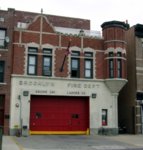
Name: FDNY Firehouse, Engine 249, Ladder 113
Address: 491 Rogers Avenue, between Midwood and Maple Streets
Neighborhood: Prospect Lefferts Gardens
Year Built: 1895-96
Architectural Style: Eclectic, with Flemish details
Architect: Peter J. Lauritzen
Other buildings by architect: Firehouse Engine 235, Monroe St. in Bed Stuy, Offerman Building on Fulton St. Downtown Brooklyn, Union League Club, Grant Square, Crown Hts North.
Landmarked: No
The story: Architect Peter J. Lauritzen designed eight firehouses for the Brooklyn Fire Department between 1895 and 1897. This one originally was designated Engine 149 and Ladder 63 in 1896, when Brooklyn was still independent from New York City. The land was bought from the Lefferts family and the firehouse built at the cost to the city of $15,700. It went into service on January 20, of that year.
When it was built, the firehouse had room on the first floor for the steam fire engine, the hose truck and ladder truck. There were six stalls for the horses, and a feed and equipment room. The second floor had a company room, offices, a dormitory for 12, and shower/bathrooms. Lauritzen’s designs included all new state of the art fire fighters’ amenities, including for the first time, hot running water for showers. This time period also saw the institution of a paid fire department, for the first time. Each man working at this house would have been on a 24 hour a day schedule, 6 days on, one day off. For this service, they received about $900 a year, averaging out to twelve cents an hour for a 144 hour week.
By the 1920’s, the firehouse was getting too small to accommodate the new fire trucks, and the doors were too narrow. The entrance was modified and enlarged, with new steel beams installed, and new doors. Unfortunately, this retrofit also stripped all of the original wood wainscoting from the main floor. It would have been gone anyway, because in 1996, the building was totally rebuilt behind the original façade, adding a third story, and an entirely modern interior. At some point, I suspect the tower sported a peaked roof, but that is long gone.
Engine 249, Ladder 113, aka “Camp Rogers Rats”, has had a proud history. Recently, one of their most respected and loved members, Lt. John H. Martinson, died in 2008, in a fire at the Ebbetts Field houses, a fire started by a child playing with paper on the stove. Their service to the city is deeply appreciated.
http://www.brownstoner.com/blog/2011/06/building-of-the-day-491-rogers-avenue/
BROWNSTONER
Building of the Day: 491 Rogers Avenue
Jun 8, 2011 by Suzanne Spellen (aka Montrose Morris)

Name: FDNY Firehouse, Engine 249, Ladder 113
Address: 491 Rogers Avenue, between Midwood and Maple Streets
Neighborhood: Prospect Lefferts Gardens
Year Built: 1895-96
Architectural Style: Eclectic, with Flemish details
Architect: Peter J. Lauritzen
Other buildings by architect: Firehouse Engine 235, Monroe St. in Bed Stuy, Offerman Building on Fulton St. Downtown Brooklyn, Union League Club, Grant Square, Crown Hts North.
Landmarked: No
The story: Architect Peter J. Lauritzen designed eight firehouses for the Brooklyn Fire Department between 1895 and 1897. This one originally was designated Engine 149 and Ladder 63 in 1896, when Brooklyn was still independent from New York City. The land was bought from the Lefferts family and the firehouse built at the cost to the city of $15,700. It went into service on January 20, of that year.
When it was built, the firehouse had room on the first floor for the steam fire engine, the hose truck and ladder truck. There were six stalls for the horses, and a feed and equipment room. The second floor had a company room, offices, a dormitory for 12, and shower/bathrooms. Lauritzen’s designs included all new state of the art fire fighters’ amenities, including for the first time, hot running water for showers. This time period also saw the institution of a paid fire department, for the first time. Each man working at this house would have been on a 24 hour a day schedule, 6 days on, one day off. For this service, they received about $900 a year, averaging out to twelve cents an hour for a 144 hour week.
By the 1920’s, the firehouse was getting too small to accommodate the new fire trucks, and the doors were too narrow. The entrance was modified and enlarged, with new steel beams installed, and new doors. Unfortunately, this retrofit also stripped all of the original wood wainscoting from the main floor. It would have been gone anyway, because in 1996, the building was totally rebuilt behind the original façade, adding a third story, and an entirely modern interior. At some point, I suspect the tower sported a peaked roof, but that is long gone.
Engine 249, Ladder 113, aka “Camp Rogers Rats”, has had a proud history. Recently, one of their most respected and loved members, Lt. John H. Martinson, died in 2008, in a fire at the Ebbetts Field houses, a fire started by a child playing with paper on the stove. Their service to the city is deeply appreciated.
http://www.brownstoner.com/blog/2011/06/building-of-the-day-491-rogers-avenue/


